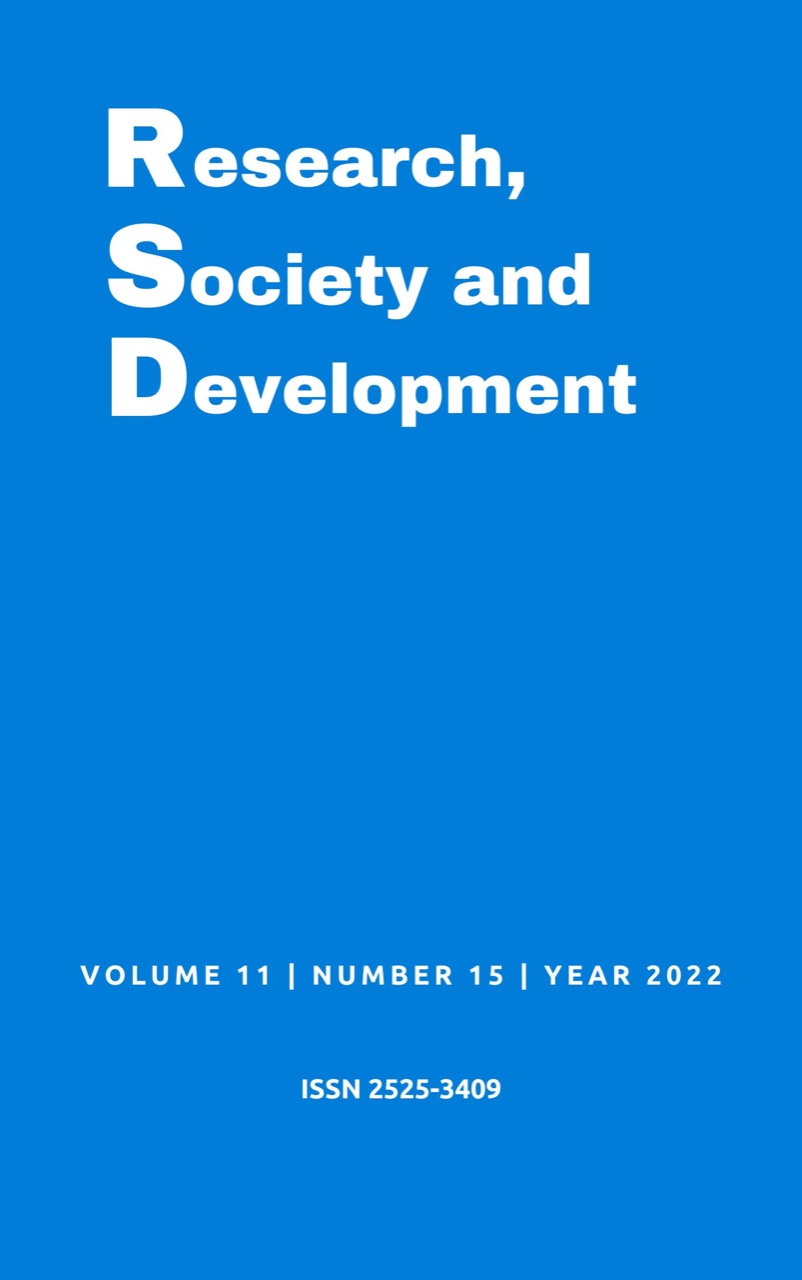Laboratory diagnosis of coagulopathies: focus on von Willebrand’s disease
DOI:
https://doi.org/10.33448/rsd-v11i15.37115Keywords:
Coagulopathies, Diagnosis, Von Von Willebrand.Abstract
Coagulation disorders are scientifically recognized as abnormalities that affect the clotting plasma structure. The most common type of coagulopathy among individuals is Von Willebrand Disease (VWD), seen as a type of hereditary origin, which can manifest from birth, or in some event of adult life, as well as being asymptomatic and undiagnosed., interfering and harming the clotting function of the body of affected individuals. This research aimed to analyze the genetic, clinical and environmental factors that favor and support the accuracy of the diagnosis for VWD. Methodologies of literature review and document analysis were used. It was a research with a qualitative approach, of a basic nature, with descriptive objectives and bibliographic procedure. The results found show that DVW affects the VWF, essential for the clotting process, being considered the most common coagulopathy, despite cases of underreporting of the disease. The conclusion of the research indicates that the accuracy of laboratory diagnosis must take into account genetic and clinical factors, in addition to using screening and additional tests to diagnose the type and subtype of the disease, in order to apply the most effective treatment.
References
Brasil. (2015). Manual das coagulopatias hereditárias raras. Ministério da Saúde.
Brasil. (2016). Manual de diagnóstico laboratorial das Coagulopatias Hereditárias e Plaquetopatias. Ministério da Saúde.
Carraro, E. C. &. (2022). Caracterização e diagnóstico da Doença de Von Willebrand. Renovare – Revista de Saúde e Meio Ambiente, 1(9), 132-148. Disponível em: http://book.uniguacu.edu.br/index.php/renovare/issue/view/98/111. Acesso em: 01 set. 2022.
El Wahsh, R., Amin, S. & Essa E. (2011). Valor diagnóstico do fator von Willebrand (VWF) em pacientes que sofrem de desconforto respiratório. Eur Respir J. 38:1686.
Freitas, S. S. (2017). Caracterização molecular da Doença de Von Willebrand tipo 2 [Dissertação de Mestrado, Universidade Federal de Minas Gerais]. Repositório do campus de Belo Horizonte. https://repositorio.ufmg.br/bitstream/1843/BUBD-AXNFP4/1/caracteriza__o_molecular_da_doen_a_de_von_willebrand_tipo_2.pdf.
Han, H., Yang, L., Liu, R. et al. (2020). Alterações proeminentes na coagulação sanguínea de pacientes com infecção por SARS-CoV-2. Clin Chem Lab Med. https://doi.org/10.1515/cclm-2020-0188.
Herculano, M. M. S. &, (2020). Doença de Von Willebrand na gestação: um relato de caso. Braz. J. of Develop., 6(8):57749-57759. https://brazilianjournals.com/ojs/index.php/BRJD/article/view/14946/12343.
Kawecki, C., Lenting, P. J. & Denis, C. V. (2017). Fator de von Willebrand e inflamação. J Thromb Haemost. 2017;15(7):1285-1294. https://doi.org/10.1111/jth.13696.
Lillicrap D. Coagulação intravascular disseminada em pacientes com pneumonia 2019-nCoV. J Thromb Haemost. 18(4):786-787. https://doi.org/10.1111/jth.14781.
Li T, Lu H, & Zhang W. (2020) Observação clínica e manejo de pacientes com COVID-19. Micróbios Emergentes Infectam. 2020;9(1):687-690. https://doi.org/10.1080/ 22221751.2020.1741327.
Liu X, Li Z, Liu S, et al. (2020) Potenciais efeitos terapêuticos do dipiridamol em pacientes graves com COVID-19. Acta Pharm Sin B. https://doi.org/10.1016/j.apsb.2020.04.008.
Longo, D. F. (2019). Diagnóstico tardio de coagulopatia hereditária após exodontia de terceiro molar. [Monografia de Graduação, Universidade do Sul de Santa Catarina]. Repositório do Campus de Tubarão. https://repositorio.animaeducacao.com.br/bitstream/ANIMA/9999/1/tcc%20d%c3%a9bora%20.pdf.
Lustosa, N. H. R. (2020). Fatores genéticos, clínicos e laboratoriais da Doença de Von Willebrand: uma revisão de literatura. In G. M. C One, & PM. L. S. Porto (org), Saúde a serviço da vida 3. IMEA. https://cinasama.com.br/wp-content/uploads/2021/09/SA%C3%9ADE-3-2020.pdf#page=17.
Mauthe M, Orhon I, Rocchi C, et al. (2018) A cloroquina inibe o fluxo autofágico ao diminuir a fusão autofagossomo-lisossomo. Autofagia. 2018;14(8):1435-1455. https://doi.org/10.1080/15548627.2018.1474314.
Obe B. H, Retter A., Mcclintock C. (2020) Orientações práticas para prevenção de trombose e manejo de coagulopatia e coagulação intravascular disseminada de pacientes infectados com COVID-19. 2020.
Pinheiro, Y. T. &. (2017). Hemofilias e Doença de Von Willebrand: uma revisão de literatura. Arch Health Invest, 6(5), 218-221. https://archhealthinvestigation.emnuvens.com.br/ArcHI/article/view/2060/pdf.
Rezende, B. M., & Figueiredo A. M. (2021). Diagnóstico laboratorial da Doença de Von Willebrand: uma revisão de literatura. Revista Salusvita – Ciências Biológicas e da Saúde, 40(2), 123-135. https://revistas.unisagrado.edu.br/index.php/salusvita/article/view/176/116.
Tang N, Bai H, Chen X, et al. (2020) O tratamento anticoagulante está associado à diminuição da mortalidade em pacientes graves com doença de coronavírus 2019 com coagulopatia. J Thromb Haemost. 18(5): 1094-1099. https://doi.org/10.1111/jth.14817.
Teles, W. S. &. (2021). Terapêutica das coagulopatias em pacientes atendidos no hemocentro de uma região do nordeste brasileiro. Research, Society and Development, 10(9), 1-9. https://rsdjournal.org/index.php/rsd/article/view/17813/16006.
Torisu T., Torisu K, Lee I. H, et al. (2013) A autofagia regula o processamento das células endoteliais, a maturação e a secreção do fator de von Willebrand. Nat Med. 2013;19(10):1281-1287. https://doi.org/10.1038/nm.3288.
Ware L. B, Eisner M. D, Thompson B. T, et al. (2004) Significado do fator von Willebrand em pacientes sépticos e não sépticos com lesão pulmonar aguda. Am J Respir Crit Care Med. 170(7):766-772. https://doi.org/10.1164/rccm.200310-1434OC.
Downloads
Published
Issue
Section
License
Copyright (c) 2022 Adria da Costa Brito; Samara Simões Barbosa Melo de Castro; Yasmin Lima Backsmann; Aline Emanuela de Souza Mafra; Haroldo Jesus dos Santos Neto; Bruna da Silva Souza Avelino

This work is licensed under a Creative Commons Attribution 4.0 International License.
Authors who publish with this journal agree to the following terms:
1) Authors retain copyright and grant the journal right of first publication with the work simultaneously licensed under a Creative Commons Attribution License that allows others to share the work with an acknowledgement of the work's authorship and initial publication in this journal.
2) Authors are able to enter into separate, additional contractual arrangements for the non-exclusive distribution of the journal's published version of the work (e.g., post it to an institutional repository or publish it in a book), with an acknowledgement of its initial publication in this journal.
3) Authors are permitted and encouraged to post their work online (e.g., in institutional repositories or on their website) prior to and during the submission process, as it can lead to productive exchanges, as well as earlier and greater citation of published work.


